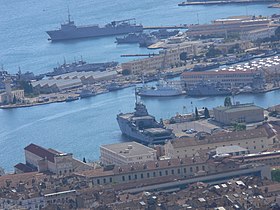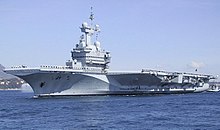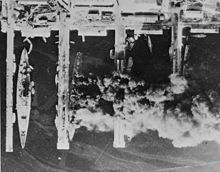Toulon arsenal
| Toulon arsenal | |
|---|---|
 Toulon arsenal | |
 Click on the map for a fullscreen view | |
| Location | |
| Location | France |
| Coordinates | 43°7′10″N 5°54′59″E / 43.11944°N 5.91639°E |

The military port of Toulon (
The Rade


The word rade comes from the old English term '
History
The 'modern' history of the port began when
In 1697,
The Arsenal port was enlarged still further in the 19th century and the 20th century. The construction of the arsenal du Mourillon began at the start of the 18th century, as an extension of the major Toulon arsenal on the roadstead's east coast. Until the 20th century this extension held stores for the wood to build the French Navy. From the late 19th century it was this shipyard that built France's first ironclad frigates then the world's first modern submarines.

Rather than joining the Free French forces in North Africa and to avoid capture by the Germans, the French fleet based at Toulon
The Arsenal is not open to the public, but the Naval Museum at its entrance has a collection of enormous ship models from the 18th century, used to train the heir to the throne in seamanship, as well as other naval memorabilia. The building of the Corderie can be seen beside the road nearby. Boat tours depart regularly from the waterfront, and allow visitors to have a good look at ships of the French fleet.[6]
Main infrastructures

The military base is divided into four main zones, each with their own access to the sea. From east to west these are:
- Castigneau ;
- Malbousquet ;
- Missiessy ;
- Milhaud.
The first has two main entrances :
- next to the civilian port - the main gate, adjoining the musée de la marine whose façade, classed as a monument historique, is the predecessor to this new gate. The new gate is located next to the arsenal's quai d'honneur and the monumental façade of the Mediterranean maritime préfecture, flanked by cannons and gilding.
- at the west entrance to Toulon town-centre - more practical than the other entrance (it is less than 200m from an autoroute exit onto four roads), it ensures freight and civil and military convoys from the base can flow freely.
The three other gates are secondary and little used, though still heavily guarded. To the extreme west in the communes of La Seyne-sur-Mer and Ollioules the military base is in contact with the commercial port of Brégaillon, connected to national and regional networks for the supply of artillery munitions and other supplies.
The arsenal du Mourillon, next to the roadstead, is directly accessible via the north arsenal which housed a submarine base until 1945. The south arsenal is accessed by the small slipway of Le Mourillon beside the now-disappeared torpedo factory.
Roads and railways
The military bases possesses more than 30 km of roads, railway level crossings, traffic lights, signs, etc.. It also has an SNCF rail line running from the station at La Seyne-sur-Mer to the docks via its storage sheds.
The naval installations of Toulon harbour are, from East to West:
- The honour quay
Used to harbour foreign ships, or large ships. Traditionally, this quay was used to honour distinguished ships by putting them into view from the merchant harbour.
- The four dry docks and the Vauban dock
The four dry docks are fit for repairs on medium to large craft. The Vaudan dock is used as a mooring for small ships (diver support, mine warfare, tugs, patrol boats) and elder ships.
- Missiessy quay and Malbousquet quay
Harbour the nuclear attack submarines. The quays are fitted with mobile roofs that cover the submarines when their nuclear equipment is being refitted. These quays also comprise a number of dry docks.
- Milhaud quays
The main mooring stations of the harbour, where frigates, aircraft carriers, fleet tankers and landing ships are stationed.
Land infrastructure of the base
Installations next to the base
See also
References
- ^ "Toulon Naval Port". VisitVar. Retrieved 10 August 2022.
- ^ "Archived copy". Archived from the original on 31 October 2020. Retrieved 4 December 2017.
{{cite web}}: CS1 maint: archived copy as title (link) - ^ Webster's New World Dictionary College Edition, 1957
- ^ Roumagnac, L'Arsenal de Toulon et La Royale, pg. 13-15)
- ^ Le suicide de la Flotte Française à Toulon by Henri Noguères Editions "J'ai lu leur aventure" n°A120/121
- ^ for the history of the Arsenal and the Port, see Cyrille Roumagnac, L'Arsenal de Toulon et la Royale Editions Alan Sutton, 2001.
